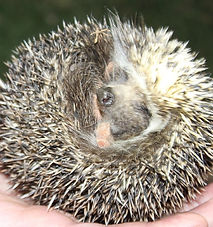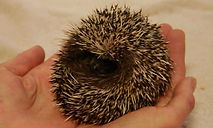IFAH PROJECT
I Found A Hedgehog
HAVE YOU SEEN A SOUTHERN AFRICAN HEDGEHOG?
Tell us when and where! SA Hedgehogs occur in Angola, Botswana, Namibia,
South Africa and Zimbabwe. We want you to tell us exactly where!

Have you seen this hedgehog?
Hedgehog News and Information

IFAH Project - Have you seen a hedgehog?
We want the whole of Southern Africa to tell us when and where they see a Southern African Hedgehog! Hedgehogs occur over throughout Southern africa and we want to known exactly where. Please report details of sightings even up to 100 years old and share the details of where (GPS coordinates/street address) and when (date). For older records you can try a give details of a decade i.e. 1960s.
Our Southern African Hedgehogs are names after their white head ban. They commonly have a dark underbelly but there are many variations, and many even have white stomachs. They are different from other hedgehogs by having five toes on their back foot, instead of four. You are most likely to find them at night or after rain storms.






50|50 Eko-ondersoek: southern African hedgehogs 31 March 2014
50|50 have produced an insert on SA hedgehogs & the IFAH project! The insert went out on the 31st March 2014 and here is the link for those that missed you. The insert gets up close and personal with a few very cute southern African hedgehogs and explained some of the threats hedgehogs face. They also speak about the IFAH project and what you should do if you find a hedgehog. Please watch this great episode!
50|50 interviewed Jessica Artingstall (MSc Zoology student & creator of the IFAH Project, Wits University), Professor Neville Pillay (small mammal behaviourist & supervisor of IFAH, Wits), Dr. Jill Drake (wildlife veterinarian and SA hedgehog rehabilitator), Nicci Wright (senior animal manager, FreeMe rehabilitation centre) and Dr. Robert Campbell (wildlife veterinarian).
50|50 has been on South Africa's TV screens for 30 years, highlighting the balance between humans and nature, and aiding in making wildlife, conservation and the environment top of mind for many a south African.
"Southern African hedgehogs are a prickly and iconic little creatures, well known for their ability to roll into a tight spiny ball! These hedgehogs are the only naturally occurring hedgehog species in southern Africa and are usually found in savanna and grassland habitats. Around southern African, rehabilitation centres and veterinarians are treating injured and sickly hedgehogs, often casualties of dog bites or hit by cars. Since hedgehogs are nocturnal, many of us have never seen one but in the gardens of Johannesburg, these cute critters keep popping up. While it may seem odd to spot these creature at your residence, many of them live in the undeveloped and protected areas throughout our cities and we should encourage them to continue living around us. In this Eko-Ondersoek, we get to know more about southern African hedgehogs, find out what to do if you find one and how you can help with important research for this species. We also follow James as he goes searching to spot his first southern African hedgehog."
For those of you might miss the episode, here is the Youtube link: www.youtube.com/watchv=om4Qpmd8w7I
"Hedgehogs in Suburbia" published in FreeMe Magazine
Southern African hedgehogs are also found within many urban areas of Greater Johannesburg, favouring Egoli granite grassland. Multiple sightings have been reported from the following suburbs: Alberton, Beaulieu, Glenferness, Krugersdorp, Kyalami, Lone Hill, Midrand, Mondeor, North Riding, Paulshof, Ruimsig and Sunninghill.
Wildlife in urban areas are usually generalists, exploiting an array of habitats. Our hedgehogs are specialists, however. They live in close proximity to undeveloped areas, especially where rocky outcrops and surfaces are common. These areas most likely serve as refugia.
Read about southern African hedgehogs living in urban areas of Johannesburg, page 21.
http://www.freeme.org.za/gup/deborah/FreeMe_2014_summer_edition.pdf
"FreeMe is a rehabilitation centre for indigenous wildlife based in the north of Johannesburg."
General information about Southern African hedgehogs
Our Southern African Hedgehogs are different from many other hedgehogs because they have a white head band across their forehead. You are most likely to find them at night or after rain storms. During the day hedgehogs shelter between rocks, under leaf litter. and between dry layers of grass.
Southern African Hedgehogs have spines covering their entire back and the top of their heads. The stomach, face and legs are covered in short brown hair. Southern African Hedgehogs get to about 20cm in length and can weigh up to 360g. Hedgehogs have a life expectancy of between 4-7 years.
Hedgehogs are well known for rolling into a ball when they are disturbed or scared, where their spines stick up straight and cover the soft underparts. These spines do not get ejected like porcupines but act as a barrier of sharp spikes for when predators try to bite them.
Hedgehogs are shown to occur through the entire Gauteng province and found in large areas of other provinces such as Limpopo, Mpumalanga, Free State, North West Province, Northern cape and Eastern cape. Hedgehogs also occur in eastern Botswana, Western Zimbabwe, Namibia and Angola.
They mainly occur in grassland and savanna habitats.These little critters mainly eat insects but will also eat earthworms, slugs, frogs, young birds, eggs, small mammals, lizards, wild fruits and vegetation. To find their food they rely on a good sense of smell and a good sense of hearing.
From May to August hedgehogs go into hibernation because of the dry and cold temperates.The Southern African Hedgehog is usually found traveling alone but can be found in pairs or groups when females have had young. Young are born during the summer months after a 40 day gestation period and litters typically have 3-6 young.